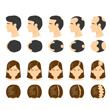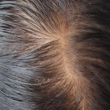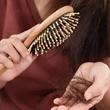Why Does a Receding Hairline Occur and How to Cure It?
A receding hairline, which is a form of hair thinning, is a critical situation. Although this sign of hair loss doesn’t make one go bald entirely, it affects specific areas of the crown and makes the overall experience bothersome. Receding hairlines can happen in any guy or girl, although the condition is most common among men. This article gives a gist of why a receding hairline occurs and what one can do for hairline regrowth.
Common Causes of Receding Hairline 1,2
A receding hairline can result from a multitude of factors. Some of them include:

1. Genetics
One common cause of a receding hairline is family history or genetics. An individual’s genes can result in androgenetic alopecia, a type of hair loss that becomes a common cause for a receding hairline. If a person has a family history of baldness, they tend to experience the same pattern of hair loss.
2. Age
Hair loss becomes a natural process when it happens with increasing age. Women tend to lose hair after menopause, although this is also common after pregnancy. In men, hair loss is likely to occur after they cross the age of 50.
3. Hormonal Changes
Hormonal changes can engender hair loss in both men and women. Both sexes can develop hormonal imbalances at any point in their life which can lead to hair loss. For instance - male pattern baldness or androgenetic alopecia occurs when an enzymatic activity converts the male sex hormone testosterone to dihydrotestosterone (DHT) which subsequently causes a balding scalp. Besides sex hormonal changes, hair loss can also occur due to issues with the thyroid gland.
4. Stress

According to research done by Harvard University, stress is linked to hair loss. In other words, a receding hairline can occur due to any stressful event, such as the loss of a loved one, emotional distress, prolonged illness, and so forth.
5. Medications
Hair loss can also result from certain medical treatments or medications. Medications, such as retinoids, birth control pills, antidepressants, epilepsy drugs, anticlotting drugs, and high blood pressure medication can lead to hair falling out. Coming to medical treatments, surgical operations like radiation, or chemotherapy can make one lose hair.
6. Lifestyle
Bad lifestyle practices such as smoking, chemical hair treatments, eating junk food, and nutrient deficiencies can play an important role in a receding hairline.
Treatment for a Receding Hairline 3,4,5
To curb hair loss and for hairline regrowth, dermatologists suggest a few effective and safe treatments.
1. Minoxidil
Minoxidil, which is available as a topical treatment, is used to treat a receding hairline that is caused by, androgenetic alopecia.
The exact usage of this medication is based on a dermatologist’s prescription.
According to certain dermatologists, high-strength minoxidil works more effectively for men struggling with receding hairlines. If they face hair loss early and use this medication, they can also reverse fine hair loss. However, they need to be consistent with its use and apply it daily without skipping it a single time.
2. Finasteride

This prescription tablet works by blocking DHT that is a common cause of male pattern baldness. Some studies show that its use not just slows down hair loss but also boosts hair regrowth.
3. Platelet-Rich Plasma Therapy
This medical procedure involves treating damaged hair follicles with the help of plasma. In this surgical procedure, the surgeon injects the individual's plasma into regions affected by hair loss.
4. Low-Level Laser Light Therapy
This medical procedure targets a laser light of a specific wavelength onto areas of the scalp to boost circulation and eventually slow down hair loss and stimulate hair growth.
5. Aromapathy
Certain scientific trials conclude that aromapathy that involves essential oils is a safe and effective treatment for certain type of hair loss, like alopecia areata. According to these trials, essential oils like rosemary oil, thyme, lavender, etc., have hair growth-promoting properties. Regular hair massages with these oils boost circulation and deliver nutrients to the scalp, thus resulting in hair growth.
6. Good Hair Care Routine
Apart from medication and massaging with oils, one must follow a proper hair care routine to combat a receding hairline and boost new hair growth. For this, try opting for gentle shampoos and conditioners. Your hair care products should be free from toxins like sulfates, mineral oils, parabens, ammonia, silicones, etc. Always condition your hair after every wash and do a deep conditioning with natural ingredients once a week. Make sure to refrain from hair styling treatments that require heat as they can damage your hair follicles. Wear good hair sunscreen before stepping outdoors. Last but not least, dry your hair naturally and opt for hairstyles that don’t put a strain on your scalp.
The Bottom Line
A receding hairline can be a stressful and unexpected experience. If you encounter it, do not ignore it and take appropriate steps as early as possible. Talk to a dermatologist and allow him to examine your condition and devise the necessary treatment for the same.
Myth Busters HairFall

Androgenetic Alopecia - Everything You Need To Know
Have you been experiencing excessive hair fall over a prolonged period of time? It could be an early sign of androgenetic alopecia. It is a hair loss disorder common in both genders and can lead to progressive thinning and even baldness in some patients if not caught and treated early.

How To Make Hair Grow Faster For Men
A head full of healthy hair is a matter of confidence. Hair has its own mechanism of growing and shedding, and it is when this mechanism is thrown off that growth is hindered. Especially in the case of males, hair growth faces a lot of hiccups that can easily be managed.

Female Pattern Baldness - Causes & Treatments
Have you suddenly noticed an increase in the number of hair strands on your pillow in the morning? Or is your ponytail getting thinner by day? Well, you might be suffering from female pattern baldness. While that does sound scary, identifying it early on is key to treating this condition effectively. So keep reading to know what this is, how you can identify it, and most importantly, what treatments you can avail of to get your beautiful lustrous hair back.

What Are The Reasons For Hairfall?
Almost everyone experiences some amount of hair thinning over the years. Shedding around 50 to 100 single strands of hair per day is considered normal. However, losing more than 150 strands a day, experiencing sudden thinning, or developing circular bald patches on your scalp are reasons for concern. Hair loss occurs when new hair doesn’t grow fast enough to replace the amount of hair you lose daily. Hair can fall due to various reasons, with hereditary hair loss and poor nutrition being the most common hair fall reasons.

Expert Approved Tips For Hair Growth
What can be more debilitating than seeing hundreds of hair strands shedding from your scalp every time you brush your hair? Also, excessive molting occurs during seasonal changes that can be very stressful for you. Although it’s okay to lose between 50-100 strands every day, according to the American Academy of Dermatology, the problem occurs when you start shedding more than normal. But that doesn’t mean you have to feel helpless as there are ways to grow your hair back. Even if you are coping with baldness or alopecia, certain hair growth tips from dermatologists can come to your rescue. Read on to discover how these tips can be your savior when abnormal hair fall problems are in sight.
Trending Videos
+ 5 Sources
'LMRC - GGI-CO-A2-DMA-300001252-300001252-WM-L21-704'
© 2021 Dr. Reddy’s Laboratories Ltd. All rights reserved.